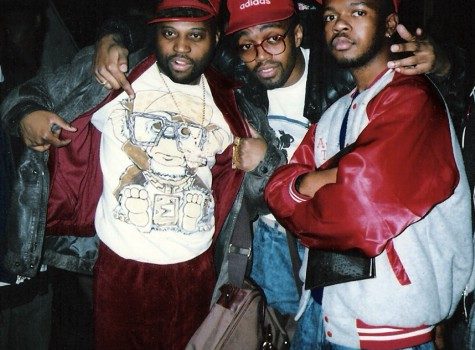Music, art, fashion, style. For a glorious moment these things all combined in an ethos of Do It Yourself. In New York City during the 1970s and 80s, the culture of Hip Hop first began to assert itself as DJs, MCs, b-boys and b-girls, created a way of rocking unlike anything the world had seen before. At the same time, graffiti had taken hold, a kind of public art so powerful and profound it became the most epic form of writing on the wall. But as the police began to crack down, buffing the trains and issuing more than desk appearance tickets to its practitioners, graffiti found new ways to express itself.
Airbrush was just the thing to allows for a smooth transition to a new kind of surface. Customized jackets, jeans, sweatshirts, and t-shirts, became the means to express yourself. It was the Shirt Kings who took this form to its highest heights, as Phade (Edwin Sacasa), Nike, and Kasheme (Rafael Avery) joined together to form the Shirt Kings, the first black clothing line straight from the streets. They went on to produce a style of clothing so iconic that it has become synonymous with the place and the time from which it spring, a zeitgeist in the making as no one could have ever predicted, not even the artists themselves.
Shirt Kings: Pioneers of Hip Hop Fashion by Edwin PHADE Sacasa and Alan KET (Dokument Press) is a vibrant photo album of their greatest hits. Phade began his graff career while a student at Art & Design, during the years when its student body included Daze, Doze Green, Lady Pink, Lil Seen, and Marc Jacobs. Outside of school, Phade was bombing the trains, living the life as it was meant to be lived.
As he recalls, “So what’s so special about the 80s? For me it was the graffiti cars swirling through New York City like canvases painted for the world to see. It was watching school comrades transform into the next generation of graffiti artists and joining the Rock Steady Crew. Getting calls to mentor and give out the wisdom I got from Kase 2 and Butch 2. Going to clubs like Harlem World on 116th Street and Lenox Avenue, Broadway International, T-Connection in the Bronx, Disco Fever, P.A.L. 183rd, Galaxy, Skate Fever, Skate-City in Brooklyn, Roseland USA and Empire Skating Rink in Brooklyn. Watching the Old Gold Crew from Brownsville, Brooklyn, fighting with their hand skills. Hearing the Supreme Team Show on the radio. Mr. Magic and Eddie Cheeba late night on the radio. Listening to hip hop with a hanger for an antenna to get some bootleg station.”
With an education like this, Phade’s evolution as an artist was natural. In 1984, the Sound 7 taught him how to airbrush, and once he acquired this skill, he began producing work, selling “Money Making New Yorker” t-shirts on the corner of 125 and Lenox Avenue. He went on to partner with Kasheme and Nike to form the Shirt Kings and launched their business in the Jamaica Coliseum in June 1986.
Jam Master Jay, a personal friend of Kasheme, came through to the opening with a crew of at least fifty. Back in the days, as hot as Hip Hop was, it was still of the people and it was grounded in the art form itself; it had not yet gone pop, had not yet hit the suburbs, or transformed into an international powerhouse. Back in the 80s, Hip Hop had an edge and it was a language spoken in the art, the dance, the music, and the lyrics.
As Alan Ket notes in his introduction, “The Shirt Kings style of airbrush design became a fashion statement made popular by the hottest rappers and deejays of the day. It seemed like overnight that their designs were everywhere from Just Ice’s record to the Audio Two’s popular album to the stage of the Latin Quarters where all the best emcees were performing weekly. As the Shirt Kings’ business took off their style was copied across the Northeast and they themselves expanded and covered Miami. Pretty soon they had deals with rappers and singers alike to provide the wardrobe designs for tours and music videos.”
Shirt Kings: Pioneers of Hip Hop Fashion takes us back to this era like nothing else ever could, the casual portraits and snapshots of the people, the art, the love of style, originality, and glamour itself. The book features portrait after portrait of some of the era’s greatest stars, along with personal quotes that remind us just how deep the Shirt Kings legacy goes. As Nas notes, “It wasn’t just rap celebrities, it was like street celebrities that had them on.” And that makes all the difference to the culture as it began to transform.
Miss Rosen
















